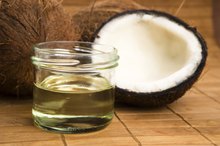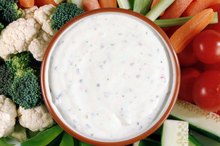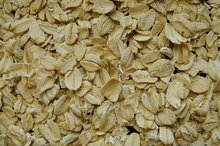How to Find Lipids on Food Labels
The nutrition facts panel describes the amount of total fat, or lipids, and the types of fats you’ll get from one serving. You’ll also find claims such as "fat-free" and "low-fat" on some packaging. These claims are not random; health claims are defined and regulated by the U.S. Food and Drug Administration.
Fats on the Label
Calories are the first item on the nutrition facts label, then the next four lines list total fat, saturated fat, trans fat and cholesterol. The label tells you the amount of each fat and the percentage of the daily value that amount fills.
The daily value, or DV, is based on consuming 2,000 calories daily, but you can still use it as a rough estimate even if you eat a different number of calories.
The DV makes it easy to identify low-fat foods. If the DV for total fat is 5 percent or less, that food is considered to be low in fat, although it's not the same as a low-fat health claim. Just remember that a low-fat food can still be high in calories.
Track Total Fat
How to Calculate Grams
Learn More
The value for total fat is important because your body depends on getting some fats through your diet. About 25 percent to 35 percent of your total daily calories should come from fats, recommends the American Heart Association. Based on a 2,000-calorie diet, that means 56 grams to 78 grams of total fats daily.
Healthy Fat Information
Most of the fats in your diet should consist of monounsaturated and polyunsaturated fats because they lower cholesterol and fight inflammation. Food manufacturers may voluntarily report them on the label, but the information isn’t required unless the product carries a health claim involving unsaturated fats.
You can calculate the amount of total unsaturated fats. First convert the value for cholesterol from milligrams to grams; for example, 100 milligrams equals 0.1 gram. Then add the grams of saturated fat, trans fat and cholesterol, and subtract that number from total fat to get unsaturated fat.
Fats to Avoid
Free List of Healthy Low-Fat Foods
Learn More
You don’t need to include saturated fat or trans fat in your diet. Some of the saturated fats in foods may raise cholesterol. Limit saturated fats to less than 7 percent of your total calories or 16 grams based on consuming 2,000 calories.
Trans fats increase bad cholesterol while lowering good cholesterol, reports the American Heart Association. If you can’t avoid trans fats, at least keep them below 1 percent of your total calories. If you eat 2,000 calories daily, that means no more than 2 grams of trans fats.
Dietary cholesterol has a small impact on blood levels of cholesterol for most healthy people, reports the Harvard School of Public Health. However, it’s still important to limit your intake to 300 milligrams or less daily.
Health Claims Defined
The FDA defines "fat-free" as a product that has 0.5 gram of fat or less per serving. A "low-fat" food must contain 3 grams or less of total fat, while a "low-saturated-fat" claim means you’ll get 1 gram or less of saturated fat.
When the label makes a claim of reduced fat, the product contains at least one-fourth less fat than the total fat in similar products. Light products have at least one-third less fat per serving.
Foods must have less than 2 milligrams of cholesterol and no more than 2 grams of saturated fat per serving to be called "cholesterol-free."
Related Articles
References
- U.S. Food and Drug Administration: How to Understand and Use the Nutrition Facts Label
- American Heart Association: Know Your Fats
- Harvard School of Public Health: Fats and Cholesterol: Out With the Bad, In With the Good
- U.S. Food and Drug Administration: Code of Federal Regulations: Food Labeling
- Colorado State University Extension: Understanding the Food Label
- USDA Food and Nutrition Service: Dietary Guidelines for Americans 2010: Foods and Food Components to Reduce
Writer Bio
Sandi Busch received a Bachelor of Arts in psychology, then pursued training in nursing and nutrition. She taught families to plan and prepare special diets, worked as a therapeutic support specialist, and now writes about her favorite topics – nutrition, food, families and parenting – for hospitals and trade magazines.









